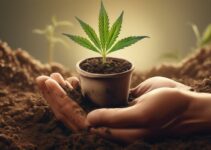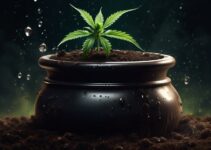When it comes to starting your seeds, you want to carefully consider the best medium for germination. Both potting soil and starter plugs have their own set of advantages and it's important to weigh them carefully. With the success of your plants at stake, it's essential to make an informed decision. So, which option will give your seeds the best chance of thriving from the start? Let's explore the factors that will help you make the right choice for your gardening needs.
Key Takeaways
- Seed starting mix is specifically designed for germinating seeds and supports strong root development in seedlings.
- Potting soil provides a balanced diet for plants with organic ingredients and supports healthy root growth and continued development.
- Seed starting mix is lighter and fluffier, making it easier for delicate seed roots to penetrate the soil.
- Potting soil may contain fertilizers and soil microbiologicals, providing additional nutrients and microbial activity.
Seed Starting Mix Characteristics
When choosing a seed starting mix, it is essential to consider its composition and specific characteristics, which play a crucial role in supporting the germination process. Seed starting mixes, also known as soilless seed starting mixes or potting mixes, are formulated from materials like sphagnum peat moss, vermiculite, coconut coir, perlite, and rice hulls. These components are chosen for their ability to provide organic matter, water retention, aeration, and drainage, all of which are essential for successful seed germination. Seed starting mixes are designed to be sterile, reducing the presence of pathogens and weed seeds. The inclusion of moisture retention granules, such as vermiculite, aids in seed development. Their light and fluffy texture facilitates easy penetration for delicate seed roots, making them an optimal medium for germinating seeds. Unlike regular potting soil, seed starting mixes do not require additional nutrients during the germination stage. Moreover, they assist in differentiating between seed germination and weeds, providing a conducive environment for the initial growth phase.
Potting Soil Composition
Considering the composition of potting soil, it encompasses a blend of materials such as sphagnum peat moss, vermiculite, coconut coir, perlite, and rice hulls, all selected for their capacity to provide essential organic matter, water retention, aeration, and drainage crucial for fostering successful seed germination. Potting soil is a nutrient-rich mix specifically designed to support seed germination and early plant growth. The organic matter in potting soil promotes microbial activity, benefiting the seedlings. Its excellent water retention properties ensure that the seeds remain consistently moist, supporting the germination process. Additionally, the aeration and drainage properties of potting soil are vital for healthy root development. Its composition, often referred to as a soilless seed starting mix, offers a sterile and well-draining environment, which is crucial for healthy root development.
| Material | Purpose | Benefit |
|---|---|---|
| Sphagnum Peat Moss | Organic matter, microbial activity support | Promotes seedling growth and development |
| Vermiculite | Water retention | Ensures consistent moisture for germination |
| Coconut Coir | Aeration | Facilitates healthy root development |
| Perlite | Drainage | Prevents waterlogging, supports root health |
| Rice Hulls | Drainage | Assists in maintaining proper soil structure |
Seed Starting Mix Benefits
Seed starting mixes offer several benefits that contribute to successful germination and early plant growth. Here are some advantages of using seed starting mixes:
- Optimal Growth: The organic materials such as sphagnum peat moss create a fluffy and light texture, providing an ideal environment for delicate seed roots to push through easily, promoting optimal growth.
- Strong Root Development: The combination of ingredients in seed starting mixes provides the perfect balance of aeration and moisture retention, leading to strong root development in seedlings.
- Enhanced Germination Rates: The sterile nature of seed starting mixes ensures a reduced presence of pathogens and weed seeds, resulting in enhanced germination rates and healthier seedlings.
- Easy Transplantation: Starting seeds in a quality mix makes it easier to transplant seedlings once they have matured, reducing transplant shock and promoting continued healthy growth.
These benefits make seed starting mixes an excellent choice for those looking to kickstart their seeds and ensure the best possible start for their future plants.
Potting Soil Benefits
To fully comprehend the benefits of potting soil for your plants, it's essential to recognize how its composition and characteristics support their development, particularly as they advance beyond the initial germination stage facilitated by seed starting mixes. Potting soil offers numerous advantages for the optimal growth of your plants. It is composed of organic ingredients such as compost, peat moss, and vermiculite, providing a balanced diet for plants. This mix retains moisture while draining excess water, creating a stable environment that supports healthy root growth. Once your plants have outgrown the seed starting phase, potting soil becomes essential as it provides the necessary nutrients and support for their continued development. Additionally, some potting soils contain soil microbiologicals or fungal causatives, promoting a healthy growing environment. The slightly acidic pH provided by peat moss in potting soil makes it particularly suitable for acid-loving plants. Therefore, using potting soil as a growing medium offers numerous benefits for your plants as they progress beyond the germination stage.
Comparing Seed Germination
When comparing the germination of seeds, it is important to consider the specific characteristics and requirements of the growing medium being used. Seed starting mix is lighter and fluffier, aiding delicate seed roots to push through easily, while potting soil is a thicker growing medium with larger pieces of organic material, suitable for established plants. Seed starting mix is often soilless, sterilized, and requires no additional nutrients during the germination stage, whereas potting soil may contain fertilizers and soil microbiologicals, offering different benefits for plant growth. Homemade potting mix can be used for transplanting seedlings or potted plants, containing equal parts compost, peat moss, and perlite.
- Seed starting mix provides a sterile environment, reducing the risk of disease transmission to germinating seeds.
- Potting soil, with its nutrient content, supports the initial growth of emerging seedlings.
- Proper moisture levels are crucial for seed germination, and the choice of growing medium can influence moisture retention.
- Using a container filled with the appropriate growing medium is essential to prevent issues such as root rot and poor germination rates.
Transplanting Young Plants
When transplanting young plants, it is crucial to handle the roots gently to minimize disturbance. Before the transplant, ensure the plants are well-watered to help keep the root ball intact during the process. After transplanting, water the plant again to help settle the soil around the roots and promote healthy growth.
Transplanting Techniques
What are the best practices for delicately transplanting young plants to ensure minimal root or stem damage and to promote continued healthy growth? When transplanting young plants, it's crucial to follow proper techniques to minimize stress and ensure successful transplantation. Here are some key steps to consider:
- Use a high-quality potting soil mix to provide the necessary nutrients for healthy seedlings.
- Gently loosen the root ball before transplanting to encourage new root growth in the new container.
- Handle the young plants with care to avoid damaging their delicate stems and roots during the transplantation process.
- Water the plants thoroughly before transplanting to reduce stress and facilitate the removal from their original container.
Adhering to these techniques will help ensure the successful transplanting of young plants and promote continued healthy growth.
Young Plant Care
To ensure the successful transplantation of young plants, handle them gently to avoid damaging their delicate roots. When transplanting, make sure the soil in the new container is prepared and ready for the young plant. Watering the young plant before transplanting helps ease its removal and reduces transplant shock. Create a hole in the new container slightly larger than the root ball of the young plant, then carefully place the plant in the hole and fill in with soil. Thoroughly water the newly transplanted young plant to help it settle into its new environment.
| Transplanting Tips | |
|---|---|
| Handle gently | Prepare new soil |
| Water before | Create hole |
| Place carefully | Water thoroughly |
Tips for Choosing the Right Soil
When choosing the right soil for your plants, consider factors such as soil moisture retention and nutrient availability. The soil should be able to retain enough moisture to support seed germination and seedling growth. Additionally, it should provide the necessary nutrients for the plants to thrive and develop strong roots.
Soil Moisture Retention
For optimal soil moisture retention, carefully consider the composition of your chosen soil to ensure it meets the specific requirements of your plants. When deciding on the best soil for seed starting and seeds to germinate, focus on retaining moisture to provide a healthy root environment. Consider using coconut coir in your soil mix as it retains moisture well. Avoid soils that may hold excess water, leading to root rot. Ensure the soil provides the perfect environment for seed germination, balancing moisture and aeration. Experiment with different soil mixes and ratios to find the ideal combination for retaining moisture while still providing the necessary support and nutrients for your plants.
- Choose soil that retains moisture effectively.
- Avoid soil with excess water retention.
- Experiment with coconut coir for better moisture retention.
- Ensure the soil provides a balanced moisture and aeration environment.
Nutrient Availability
Consider the specific nutrient requirements of your plants by reading seed packets or plant labels to identify the most suitable soil for optimal growth and development. When it comes to nutrient availability, both potting soil and starter plugs play important roles in providing the ideal environment for seed starting. Espoma Seed Starting Mix, for example, offers a perfect blend of essential nutrients to support young seedlings. It is crucial to ensure that your chosen soil type can retain enough water without becoming waterlogged while also providing adequate drainage to prevent root rot. Additionally, you may consider incorporating additional ingredients such as organic matter or compost to enhance the nutrient availability in your soil mix. By carefully selecting a soil mix that meets the specific nutrient requirements of your plants, you can create a favorable environment for successful germination and healthy growth.
Frequently Asked Questions
Which Soil Is Best for Seed Germination?
For seed germination, a well-draining seed starting mix is best, promoting water retention, oxygen exchange, and root development. This optimizes seedling growth, nutrient availability, pH levels, and disease prevention, ensuring transplant success and moisture control.
Is Seed Starting Mix Better Than Potting Soil?
Seed starting mix is better for seedling development due to its superior moisture retention, soil aeration, and disease prevention. Nutrient availability, pH levels, and root growth are optimal, facilitating successful transplantation and minimizing watering frequency.
Is It Better to Germinate Seeds in Soil Or?
When germinating seeds, it's crucial to consider soil vs. plugs. Soil provides a stable growing medium for root development, plant nutrition, and microbial activity. Ensure proper soil moisture and watering methods for successful seedling transplanting and growth.
What Is the Best Medium for Germinating Seeds?
For hydroponic germination, use a mix of peat moss, vermiculite for moisture retention, coconut coir, and perlite for aeration. Seedling trays with proper germination temperatures and nutrition are vital. Consider aeroponic germination or Jiffy pellets for convenience.





